重庆医科大学:《诊断学》课程教学资源(授课教案)06 腹泻
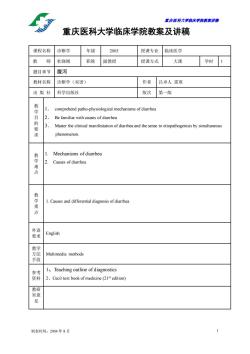
置庆医科大学脑床学院讲满 重庆医科大学临床学院教案及讲稿 课程名称诊断学 年级2005 授课专业临床医学 教师杜晓刚 职称副教授 授课方式 大课 学时1 题目章节腹泻 教材名称诊断学(双语) 作者吕卓人雷寒 出版社科学出版社 版次第一版 comprehend patho-physiological mechanisms of diarrhea 2. Be familiar with causes of diarrhea 的要求 Master the clinical manifestation of diarrhea and the sense to etiopathogenisis by simultaneous phenomenon. Mechanisms of diarrhea 教学难点 2. Causes of diarrhea 教学重点 1.Causes and differential diagnosis of diarrhea English Multimedia methods 手段 1.Teaching outline of diagnostics Cecil text book of medicine (edition) 教研 见 制表时间:2004年8月
重庆医科大学临床学院教案讲稿 制表时间:2004 年 8 月 1 重庆医科大学临床学院教案及讲稿 课程名称 诊断学 年级 2005 授课专业 临床医学 教 师 杜晓刚 职称 副教授 授课方式 大课 学时 1 题目章节 腹泻 教材名称 诊断学(双语) 作者 吕卓人 雷寒 出 版 社 科学出版社 版次 第一版 教 学 目 的 要 求 11. comprehend patho-physiological mechanisms of diarrhea 12. Be familiar with causes of diarrhea 13. Master the clinical manifestation of diarrhea and the sense to etiopathogenisis by simultaneous phenomenon. 教 学 难 点 11. Mechanisms of diarrhea 12. Causes of diarrhea 教 学 重 点 1. Causes and differential diagnosis of diarrhea 外语 要求 English 教学 方法 手段 Multimedia methods 参考 资料 1、Teaching outline of diagnostics 2、Cecil text book of medicine (21st edition) 教研 室意 见
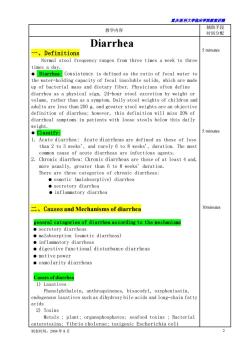
露庆医科大学临床半院载案讲满 教学内容 辅助手段 时间分配 Diarrhea 一、Definitions minutes Normal stool frequency ranges from three times a week to three imes a day Diarrhea Consistency is defined as the ratio of fecal water the water-holding capacity of fecal insoluble solids,which are made up of bacterial mass and dietary fiber.Physicians often define diarrhea as a physical sign.24-hour stool excretion by weight or volume,rather than as a symptom.Daily stool weights of children and adultsare less and greater stoo definition of diarrhea:however,this definition will miss 20%of diarrheal symptoms in patients with loose stools below this daily weight. ●C1 assify: minutes 1. Acute diarrhea:Acute diarrheas are defined as those of less than 2 to 3 weeks',and rarely 6 to 8 weeks',duration.The most common cause of acute diarrheas are infectious agents. 2.Chronic diarrhea:Chronic diarrheas are those of at least 4 and, osmotic (malabsorptive)diarrhea ●secretory diarrhea inflammatory diarrhea 二、Causes and Mechanisms of diarrhea 10minutes general categories of diarrhea according to the mechanisms ●secretory diarrheas malabsorption (osmotic diarrheas) inflammtory diarrheas digestive functional disturbance diarrheas ●motive power osmolarity diarrheas Causes of diarrhea 1)Laxatives Phenolphthalein,anthraquinones,bisacodyl,oxyphenisatin, endogenous laxatives such as dihydroxy bile acids and long-chain fatty acids 2)Toxins Metals plant;organophosphates;seafood toxins Bacterial enterotoxins:Vibrio cholerae;toxigenic Escherichia coli 制表时间:2004年8月
重庆医科大学临床学院教案讲稿 制表时间:2004 年 8 月 2 教学内容 辅助手段 时间分配 Diarrhea 一、Definitions Normal stool frequency ranges from three times a week to three times a day. ● Diarrhea: Consistency is defined as the ratio of fecal water to the water-holding capacity of fecal insoluble solids, which are made up of bacterial mass and dietary fiber. Physicians often define diarrhea as a physical sign, 24-hour stool excretion by weight or volume, rather than as a symptom. Daily stool weights of children and adults are less than 200 g, and greater stool weights are an objective definition of diarrhea; however, this definition will miss 20% of diarrheal symptoms in patients with loose stools below this daily weight. ● Classify: 1. Acute diarrhea: Acute diarrheas are defined as those of less than 2 to 3 weeks', and rarely 6 to 8 weeks', duration. The most common cause of acute diarrheas are infectious agents. 2. Chronic diarrhea: Chronic diarrheas are those of at least 4 and, more usually, greater than 6 to 8 weeks' duration. There are three categories of chronic diarrheas: ● osmotic (malabsorptive) diarrhea ● secretory diarrhea ● inflammatory diarrhea 二、Causes and Mechanisms of diarrhea general categories of diarrhea according to the mechanisms ● secretory diarrheas ● malabsorption (osmotic diarrheas) ● inflammatory diarrheas ● digestive functional disturbance diarrheas ● motive power ● osmolarity diarrheas Causes of diarrhea 1) Laxatives Phenolphthalein, anthraquinones, bisacodyl, oxyphenisatin, endogenous laxatives such as dihydroxy bile acids and long-chain fatty acids 2) Toxins Metals ; plant; organophosphates; seafood toxins ; Bacterial enterotoxins; Vibrio cholerae; toxigenic Escherichia coli 5 minutes 5 minutes 10minutes
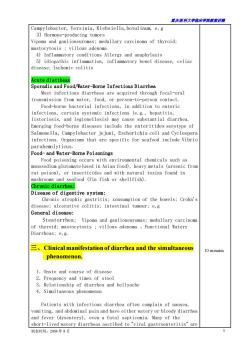
重庆医科大学脑床半院载未讲满 Campylobacter,Yersinia,Klebsiella,botulinum,e.g 3)Hormone -roducing tumors Vipoma and ganlioneuromas;medullary carcinoma of thyroid: mastocytosis villous adenoma 4)Inflammatory conditions Allergy and anaphylaxis 5)idiopathic inflammation,inflammatory bowel disease,celiac disease:Ischemic colitis Acute diattheas Sporadic and Food/Water-Borne Infectious Diarrhea Most infectious diarrheas are acquired through fecal-oral transmission from water,food,or person-to-person contact. Food-borne bacterial infections,in addition to enteric nfections certain systemic infections (e.g., epatitis, listeriosis,and legionellosis)may cause substantial diarrhea. Emerging food-borne diseases include the enteritides serotype of Salmonella,Campylobacter jejuni,Escherichia coli and Cyclospora infections.Organisms that are specific for seafood include Vibri parahemolyticus. Food-and Water-Borne Poisonings Food poisoning occurs with environmental chemicals such as monosodium glutamate(used in Asian food),heavy metals (arsenic from rat poison), or insecticides and with natural toxins found in mushrooms and seafood (fin fish or shellfish) Chronic diarrhea: Disease of digestive system: Chronic atrophic gastritis;xonsumption of the bowels;Crohn's disease;ulcerative colitis;intestinal tumour;e.g General disease: Steatorrhea:Vipoma and ganlioneuromas:medullary carcinom of thyroid:mastocytosis villous adenoma 、Functional Watery Diarrheas:e,g. Clinical manifestation of diarrhea and the simultaneous 10 minutes phenomenon. 1.Onste and course of disease 2.Frequency and times of stool 3.Relationship of diarrhea and bellyache 4.Simultaneous phenomenon Patients with infectious diarrhea often complain of nausea, vomiting,and abdominal pain and have either watery or bloody diarrhea and fever (dysentery),even a fatal septicemia.Many of the short-lived watery diarrheas ascribed to "viral gastroenteritis"are 制表时间:2004年8月
重庆医科大学临床学院教案讲稿 制表时间:2004 年 8 月 3 Campylobacter, Yersinia, Klebsiella,botulinum, e.g 3) Hormone-producing tumors Vipoma and ganlioneuromas; medullary carcinoma of thyroid; mastocytosis ; villous adenoma 4) Inflammatory conditions Allergy and anaphylaxis 5) idiopathic inflammation, inflammatory bowel disease, celiac disease; Ischemic colitis Acute diattheas Sporadic and Food/Water-Borne Infectious Diarrhea Most infectious diarrheas are acquired through fecal-oral transmission from water, food, or person-to-person contact. Food-borne bacterial infections, in addition to enteric infections, certain systemic infections (e.g., hepatitis, listeriosis, and legionellosis) may cause substantial diarrhea. Emerging food-borne diseases include the enteritides serotype of Salmonella, Campylobacter jejuni, Escherichia coli and Cyclospora infections. Organisms that are specific for seafood include Vibrio parahemolyticus. Food- and Water-Borne Poisonings Food poisoning occurs with environmental chemicals such as monosodium glutamate(used in Asian food), heavy metals (arsenic from rat poison), or insecticides and with natural toxins found in mushrooms and seafood (fin fish or shellfish). Chronic diarrhea: Disease of digestive system: Chronic atrophic gastritis; xonsumption of the bowels; Crohn's disease; ulcerative colitis; intestinal tumour; e,g General disease: Steatorrhea; Vipoma and ganlioneuromas; medullary carcinoma of thyroid; mastocytosis ; villous adenoma 、Functional Watery Diarrheas; e,g. 三、Clinical manifestation of diarrhea and the simultaneous phenomenon. 1.Onste and course of disease 2.Frequency and times of stool 3.Relationship of diarrhea and bellyache 4.Simultaneous phenomenon Patients with infectious diarrhea often complain of nausea, vomiting, and abdominal pain and have either watery or bloody diarrhea and fever (dysentery), even a fatal septicemia. Many of the short-lived watery diarrheas ascribed to "viral gastroenteritis" are 10 minutes
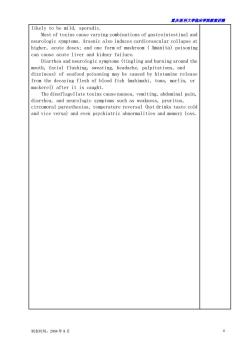
露庆医科大学脑床半院藏来讲滴 likely to be mild,sporadic. Most of toxins cause varying combinations of gastrointestinal and neurologic symptoms.Arsenic also induces cardiovascular collapse at higher,acute doses;and one form of mushroom Amanita)poisoning can cause acute liver and kidney failure. Diarrhea and neurologic symptoms(tingling and burning around the nouth,facial flushing,sweating,headache,palpitations,and dizziness)of seafood poisoning may be caused by histamine release from the decaying flesh of blood fish (mahimahi,tuna,marlin,or mackerel)after it is caught. The dinoflagellate toxins cause nausea,vomiting,abdominal pain diarrhea, and neurologi symptoms pruritus, circumoral paresthesias.terperatureversa hot rinks tasto col and vice versa)and even psychiatric abnormalities and memory loss. 制表时间:2004年8月 4
重庆医科大学临床学院教案讲稿 制表时间:2004 年 8 月 4 likely to be mild, sporadic. Most of toxins cause varying combinations of gastrointestinal and neurologic symptoms. Arsenic also induces cardiovascular collapse at higher, acute doses; and one form of mushroom ( Amanita) poisoning can cause acute liver and kidney failure. Diarrhea and neurologic symptoms (tingling and burning around the mouth, facial flushing, sweating, headache, palpitations, and dizziness) of seafood poisoning may be caused by histamine release from the decaying flesh of blood fish (mahimahi, tuna, marlin, or mackerel) after it is caught. The dinoflagellate toxins cause nausea, vomiting, abdominal pain, diarrhea, and neurologic symptoms such as weakness, pruritus, circumoral paresthesias, temperature reversal (hot drinks taste cold and vice versa) and even psychiatric abnormalities and memory loss
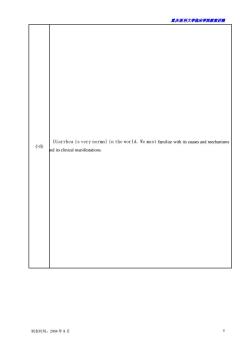
置庆医科大学脑床半院末讲满 Diarrhea is very normal in the world.We mast familiar with its causes and mechanisms 小结 d itsincamnifestations 制表时间:2004年8月
重庆医科大学临床学院教案讲稿 制表时间:2004 年 8 月 5 小结 Diarrhea is very normal in the world. We mast familiar with its causes and mechanisms and its clinical manifestations
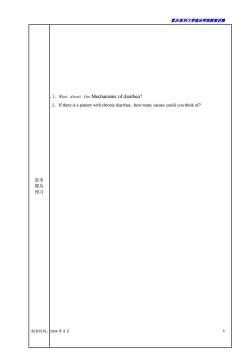
置庆医科大学临床半院表素讲满 .1.What about the Mechanisms of diarrhea? 2.If there is a patient with chronic diarrhea,how many causes could you think of? 脑 制表时间: 2004年8月 6
重庆医科大学临床学院教案讲稿 制表时间:2004 年 8 月 6 思考 题及 预习 1.1.What about the Mechanisms of diarrhea? 2.If there is a patient with chronic diarrhea , how many causes could you think of?
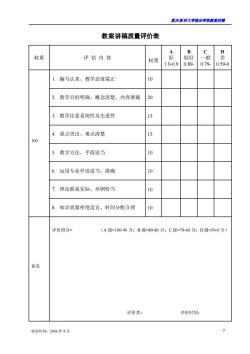
重庆医科大半临床半院载案讲满 教案讲稿质量评价表 B D 权重 评估内容 权重 好 较好 一般 若 1.0-0.90.89 0.79. 0.59-0 编写认真、教学态度端正 教学目的明确、概念清楚、内容准确 20 3.教学注意系统性及先进性 15 4.重点突出、难点清楚 15 100 5. 教学方法、手段适当 10 6. 运用专业外语适当、准确 10 1. 理论联系实际、举例恰当 o 8.知识容量密度适宜、时间分配合理 平价得分= (A级=100-90分:B级=89-80分:C级=79-60分:D级=59-0分) 意见 评价者: 评价时间: 制表时间:2004年8月
重庆医科大学临床学院教案讲稿 制表时间:2004 年 8 月 7 教案讲稿质量评价表 权重 评 估 内 容 权重 A 好 1.0-0.9 B 较好 0.89- C 一般 0.79- D 差 0.59-0 100 1. 编写认真、教学态度端正 10 2. 教学目的明确、概念清楚、内容准确 20 3. 教学注意系统性及先进性 15 4. 重点突出、难点清楚 15 5. 教学方法、手段适当 10 6. 运用专业外语适当、准确 10 7. 理论联系实际、举例恰当 10 8. 知识容量密度适宜、时间分配合理 10 意见 评价得分= (A 级=100-90 分;B 级=89-80 分;C 级=79-60 分;D 级=59-0 分) 评价者: 评价时间:
按次数下载不扣除下载券;
注册用户24小时内重复下载只扣除一次;
顺序:VIP每日次数-->可用次数-->下载券;
- 重庆医科大学:《诊断学》课程教学资源(授课教案)05 腹痛.doc
- 重庆医科大学:《诊断学》课程教学资源(授课教案)07 黄疸.doc
- 重庆医科大学:《诊断学》课程教学资源(授课教案)02 水肿.doc
- 重庆医科大学:《诊断学》课程教学资源(授课教案)01 绪论与问诊.doc
- 重庆医科大学:《诊断学》课程教学资源(授课教案)08 腹部检查.doc
- 重庆医科大学:《诊断学》课程教学资源(授课教案)09 病历与诊断.doc
- 重庆医科大学:《诊断学》课程教学资源(授课教案)03 呕血.doc
- 重庆医科大学:《诊断学》课程教学资源(授课教案)04 便血.doc
- 重庆医科大学:《实验诊断学》课程教学资源(PPT课件)第八讲 脑脊液常规及生殖系统检查.ppt
- 重庆医科大学:《实验诊断学》课程教学资源(PPT课件)第七讲 大便常规、免疫学检查及心肌标志物检查.ppt
- 重庆医科大学:《实验诊断学》课程教学资源(PPT课件)第六讲 肾功能检查(主讲:唐敏).ppt
- 重庆医科大学:《实验诊断学》课程教学资源(PPT课件)第四讲 血栓与出血检查(主讲:胥文春).ppt
- 重庆医科大学:《实验诊断学》课程教学资源(PPT课件)第三讲 骨髓细胞学检查、血型与输血.ppt
- 重庆医科大学:《实验诊断学》课程教学资源(PPT课件)第一讲 总论及血液一般检查(上).ppt
- 上海科学技术出版社:《实验诊断学——彩色图谱》书籍PDF电子版(主编:张丽霞、陈金宝).pdf
- 重庆医科大学:《实验诊断学》课程复习题集(无答案).doc
- 《实验诊断学》课程实验指导书 laboatoty diagnosis(共九章,含练习及答案).doc
- 重庆医科大学:《实验诊断学》课程教学资源(教案)第8讲 CSF生殖系统.doc
- 重庆医科大学:《实验诊断学》课程教学资源(教案)第7讲 大便 免疫 心肌.doc
- 重庆医科大学:《实验诊断学》课程教学资源(教案)第6讲 肾功能.doc
- 重庆医科大学:《诊断学》课程教学资源(授课教案)14 心电图.doc
- 重庆医科大学:《诊断学》课程教学资源(授课教案)11 心脏检查.doc
- 重庆医科大学:《诊断学》课程教学资源(授课教案)20 呼吸系统症状和体征.doc
- 重庆医科大学:《诊断学》课程教学资源(授课教案)13 循环系统主要症状与体征.doc
- 重庆医科大学:《诊断学》课程教学资源(授课教案)15 超声心动图检查.doc
- 重庆医科大学:《诊断学》课程教学资源(授课教案)12 血管检查.doc
- 重庆医科大学:《诊断学》课程教学资源(授课教案)10 发热.doc
- 重庆医科大学:《诊断学》课程教学资源(授课教案)19 胸部检查.doc
- 重庆医科大学:《诊断学》课程教学资源(授课教案)18 呼吸困难.doc
- 重庆医科大学:《诊断学》课程教学资源(授课教案)16 咳嗽、咳痰.doc
- 重庆医科大学:《诊断学》课程教学资源(授课教案)17 咯血.doc
- 医学临床本科《MRI诊断学》课程教学大纲 Magnetic Resonance Imaging Diagnosis.doc
- 医学临床本科《影像诊断学》课程教学大纲 medical imaging(包含MRI部分).doc
- 医学影像本科《MRI诊断学》课程教学大纲(Magnetic Resonance Imaging Diagnosis).doc
- 石河子大学:《MRI诊断学》课程教学资源(讲稿,共五章).doc
- 石河子大学:《MRI诊断学》课程教学课件(PPT讲稿)第一章 MRI总论.ppt
- 石河子大学:《MRI诊断学》课程教学课件(PPT讲稿)第三章 呼吸系统 3.1 3.2 正常及异常.ppt
- 石河子大学:《MRI诊断学》课程教学课件(PPT讲稿)第三章 呼吸系统 3.3 支气管扩张及肺部炎症.ppt
- 石河子大学:《MRI诊断学》课程教学课件(PPT讲稿)第三章 呼吸系统 3.4 肺结核.ppt
- 石河子大学:《MRI诊断学》课程教学课件(PPT讲稿)第三章 呼吸系统 3.5 肺肿瘤.ppt
